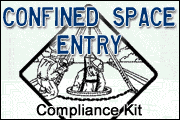Confined Space Training | |||
Best-Selling Training Courses:Self-Study Materials | |||
About Confined SpacesEvery year, hundreds of workers suffer needless injuries, even death, due to inadequate understanding of confined spaces safety requirements.Many workplaces contain spaces that are considered "confined" because their configurations hinder the activities of employees who must enter, work in, and exit from. What Is The OSHA Definition Of A Confined Space? According to OSHA, a confined space has limited or restricted means for entry or exit, and is not designed for continuous occupancy. Confined spaces include, but are not limited to, tunnels, tanks, vessels, silos, storage bins, hoppers, vaults, pits, manholes, tunnels, equipment housings, ductwork, pipelines, etc. OSHA defines a confined space as being made up of three main parts: 1) being large enough for an employee to enter and perform work; 2) has limited or restricted means for entry or exit, and: 3) is not designed for continuous occupancy. Examples Of Confined Spaces Confined spaces include, but are not limited to, sewers, pipes, access shafts, truck or rail tank cars, aircraft wings, boilers, silos, vats, pits, tunnels, manholes, tanks, vessels, storage bins, hoppers, vaults, equipment housings, ductwork, pipelines, etc. What Are The Base Requirements For Working In A Confined Space? Because they are inherently dangerous, confined spaces are heavily regulated. They require employers to develop a written program to address the potential risks associated with whomever may enter a confined space, the type of training, appropriate safety equipment, how to monitor the space and employee(s) from outside the space, and emergency procedures. What You'll Learn From Our Confined Spaces Training:
 Find Confined Space Training CoursesTo find your desired Confined Space training courses, either select a Recommended Course from the list below, or "Confined Spaces" and your state from the "Professional Development" section of the search box at the bottom of this page. | |||
Best-Selling Training Courses:Self-Study Materials | |||
Find Seminars, Webinars, And Online Training In Your Area | |||
More About Confined SpacesAccording to OSHA (https://www.osha.gov/SLTC/confinedspaces), many workplaces contain areas that are considered "confined spaces" because while they are not necessarily designed for people, they are large enough for workers to enter and perform certain jobs. A confined space also has limited or restricted means for entry or exit and is not designed for continuous occupancy. Confined spaces include, but are not limited to, tanks, vessels, silos, storage bins, hoppers, vaults, pits, manholes, tunnels, equipment housings, ductwork, pipelines, etc.OSHA uses the term "permit-required confined space" (permit space) to describe a confined space that has one or more of the following characteristics: contains or has the potential to contain a hazardous atmosphere; contains material that has the potential to engulf an entrant; has walls that converge inward or floors that slope downward and taper into a smaller area which could trap or asphyxiate an entrant; or contains any other recognized safety or health hazard, such as unguarded machinery, exposed live wires, or heat stress. Click through to https://www.osha.gov/SLTC/confinedspaces to see additional information. | |||
| Share on Facebook Share on Twitter |